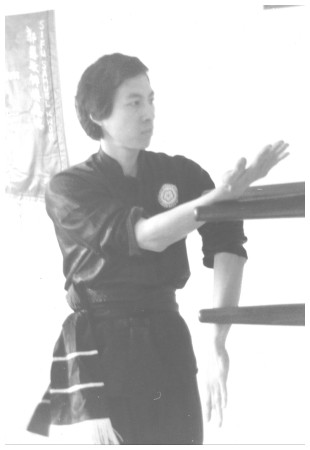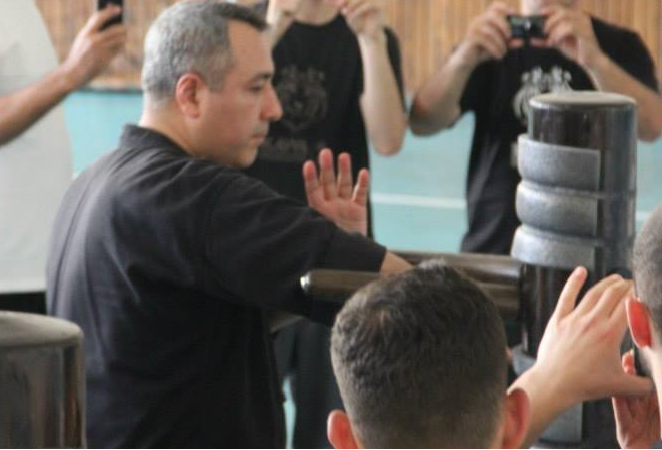
 Origins of the Wooden Dummy (legend)…
Origins of the Wooden Dummy (legend)…
Siu Lam Monastery was the cradle that hatched many of the greatest martial artists through the generations. Legend has it that there was a tunnel filled with 108 wooden men), and each monk who wished to complete his training had to battle his way through this tunnel as one of his final exams. Each one of these wooden men (known as bronze monks) performed a unique set techniques, which the "graduate" monks had to immobilize.
When the Siu Lam Temple was burned down by the Manchurian Government, one of the five Buddhist monks who escaped from the ordeal had incorporated 108 techniques into a single Wooden Dummy set, and each technique was originally from the 108 wooden men in the ‘Wooden Dummy Alley’.
Whether the wooden dummy appeared before or after the creation of Wing-Chun-Kuen, it is true that the Wooden Dummy set in Wing-Chun training is an excellent apparatus for the Wing-Chun students to develop, refine the skills and footwork coordination needed to become a skilled practitioner.
Mook-Yan-Jong
Wooden Dummy Form: 108 Moves
Mook-Yan-Jong is a training device precious to the Wing-Chun system. It is the final stage of training for hand and foot techniques. Therefore, those who have studied this form must have achieved a high level of proficiency in the art of Wing-Chun. The Jong techniques include practically all of the hand and foot techniques. They are those techniques in various combinations and applications. These can be broken down into three categories:
1) Neutralization maneuver
2) Confrontation and counter Attacks and
3) Blatant Attacks.
Precision and understanding are of the utmost importance. The form trains one to respond to an attack with a counter that is not only instantaneous and spontaneous, but the most appropriate and effective in any given situation. Some techniques may not seem to conform to Wing-Chun’s theory of economy of motion, but they are actually to compensate for the fact that the Jong itself doesn’t turn as a real opponent would when struck or blocked with force. Remember it is a training device, not a real fight!
The Jong also teaches the proper hand and foot distancing between the student and an opponent so as to prevent jamming of hand/leg techniques and the resultant blocking of chi.
When studying the Jong, importance is placed on the understanding and sequence of movements and mastering them fully. Approach the Jong as one would an opponent, with the intent of mastering it and not vice versa. Understand and master each section before moving to the next one. Allow time for understanding of each section and applying it to your Chi-Sao. You can also practice this form "empty-handed” without the use of the Jong, in order to realize the full potential of your movements. Both modes are essential to proper training.
The wooden dummy has three arms, one front leg, and a rear leg (bottom trunk of the dummy). This is sufficient to represent a human body in various positions, for the purposes of training. The dummy can be mounted several ways, on springs, or is connected at the upper and lower parts to a supporting frame. This type of dummy is the most popular nowadays; it can be used in any gymnasium or at home. This type of dummy will react with a vivid rebound when struck and is more realistic substitute for an opponent during the training.
In the old days, the dummy was built using a very long stake, of which the greater part was embedded into the ground in a garden or an empty ground outside the house. This type of dummy is advantageous for strengthen the limbs. It also allows the practitioner to experience powerful charging forces because it does not react when struck.
The Dummy is the most versatile tool for practicing body positions, especially executing Wing-Chun techniques and moving in on the opponent. However, during the training, the practitioner should bear in mind that the dummy is not designed to strengthen his limbs but to train him to gain from one superior position to another by taking up the most suitable position through footwork coordination. When executing the dummy set, the practitioner should go slowly and pay attention to detail in each section of techniques. The trainee who makes the noisiest movements while executing the dummy set does not make the best use of it. The dummy also trains the practitioner to generate the unique power from the entire body and footwork as one unity to shake up the Jong. During the training of the Muk Yang Jong Fa, a practitioner who reaches the proficiency level should be able to perform the dummy set without the actual dummy.

The Wooden Dummy encloses the techniques that are divided into eight sections, as briefly described below:
1. Section I: Ten movements beginning from the left pre-fighting posture, mainly consisting of the Neck-Pulling Hand (Mang-Geng-Sao), Tan-Sao, Dai-Bong-Sao, Yu-Dai-Cheung (Lower Lying-Palm strike), Gaun-Sao, Kwun-Sao, Jut-Sao and Jaun-Sao. In this section, stress is placed on footwork, such as Yee-Chi-Kim-Yeung-Ma, Chuen-Ma, Tor-Ma, Sip-Ma.
2. Section II: Ten movements beginning from the right pre-fighting posture. As usual, in Wing Chun forms, a technique set begins from the left side and then repeats from the right side.
3. Section III: Ten movements beginning from the Noi-Pak-Sao/Wei Pak-Sao (in-door/out-door slap-blocks), Fak-Sao (throat-cutting hand), Jut-Sao and lower thrusting punch. This section also offers valuable palm exercises for both offense and defense.
4. Section IV: Nine movements beginning from the Dai-Bong-Sao, Wu-Sao, Fak-Sao, Kau-Sao, and Waang-Gerk .The importance of this section lies in the variation of Inquisitive-arms and their coordination with the side thrusting kick. Stress is placed on the application of the skill of ‘Thrust forward while the hand is freed’, to launch a counter attack with the arm of the leg while being hard-pressed by the opponent’s powerful attack.
5. Section V: Twenty-one movements beginning from the double Tan-Sao/Biu Jong-Sao, Huen-Sao, Po-Pai-Cheung, Kau-Sao, Jut-Sao, Yang-Cheung, Bong-Sao, Yu-Dai-Cheung, and Fook-Gerk. In this section, the practitioner learns how to steal the opponent’s defensive line and counter attack utilizing circle block and skilful footwork.
6. Section VI: Fifteen movements beginning from the Fook Sau. It mainly focuses on the training of Po-Pai-Cheung with the coordination of footwork.
7. Section VII: Fifteen movements beginning from the left and right double Gaun-Sao, Bong-Sao, Tang-Sao, Fak Sau. New foot work is introduced in this section is Lau Ma. Stress is laid on the changing of the Bong-Sao to the grappling hand and its application in coordination of palm attacks. Crossed Stamp Kick with Lau-Ma, the most tactical kicking technique in the entire system.
8. Section VIII: Twenty-Six movements beginning from left to right Dai-Bong-Sao. Fook-Gerk, Jeet-Gerk, Che-Gerk, Yau-Wai Dai-Gerk are the kicking techniques introduced in this section.